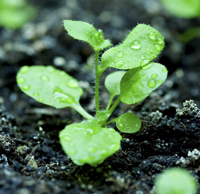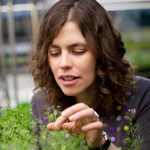Learning How Genetic Seeds Are Sown
|
|
To understand how embryos develop, many researchers look to animal models such as worms and frogs. But Mary Gehring, a 2011 Pew Biomedical Scholar and assistant professor of biology at the Massachusetts Institute of Technology, turns to plants—even weeds.
Gehring was weighing the option of graduate school when Norman Borlaug—winner of the 1970 Nobel Peace Prize and “father of the green revolution”—gave a talk at her college. She had studied as an undergraduate at Williams College in a plant biology lab, and hearing about Borlaug's work further persuaded her to use plants as a model in developmental biology and genetics.
“This was a person who had a huge impact not only in science, but more broadly in terms of world hunger and peace … all from breeding work with plants,” said Gehring, now a member of MIT's Whitehead Institute for Biomedical Research.
Gehring was always interested in nature. She grew up among farms and apple orchards in rural Michigan, and because her father was a biology teacher she was used to having tarantulas, cockroaches, and piranhas around. “Biology was in the air,” she said.
"I got really excited about the genetics that were underlying what you could see when plants grew and developed."
Gehring was initially unsure whether to major in biology or English since she wanted to write: She was particularly drawn to poems and short stories. But a lesson in her genetics class inspired Gehring to move toward a biology degree. “We were learning how flowers formed, and I got really excited about the genetics that were underlying what you could see when plants grew and developed,” she said.
 Mary Gehring studies a weed known as Arabidopsis. |
Gehring joined an energy-efficiency consultancy group after graduation. Within a year, however, she had enrolled as a graduate student at the University of California, Berkeley, and joined a molecular biology lab. Its focus was Polycomb genes, which control the expression of many other genes and are common to organisms ranging from fruit flies to people to the weed Arabidopsis—the plant world's version of the lab rat. After earning her doctorate from Berkeley in 2005, Gehring continued her training at the Fred Hutchinson Cancer Research Center in Seattle. Her attention then shifted to how chemical signposts on DNA regulate genetic imprinting, a phenomenon in which either the maternal or paternal version of a particular gene gets turned on in the seed while that from the other parent is turned off.
Although small in number, imprinted genes are power players early on, such as when a plant embryo is maturing into a seed. Gehring is especially interested in how imprinted genes can act as master switches in seed development.
She hopes to understand how epigenetic influences—the environmental factors governing how genes are switched on or off—contribute to evolutionary changes in generations of plants. “We really would like to know what is going on epigenetically as a gamete develops into a viable seed,” she said.
As one of the 22 early-career scientists named Pew Biomedical Scholars in 2011, Gehring now has her first research funding as an independent scientist. That, she anticipates, will help to move her science forward, allowing for “creativity in research that might be harder to do with a traditional federal grant.”
She has since picked up another honor, as one of two recipients of the 2013 Rosalind Franklin Young Investigator Award. And although her work is basic science through and through, the essence of Borlaug's talk has never left her. Remembering how the plant biologist said that “not enough young people were going into science,” Gehring seems to have taken him up on the challenge—in the hope that her findings in plants will take root for the sake of human health.
See more profiles here.
Photo of Mary Gehring by Kathleen Dooher/Whitehead Institute.
Since 1985, Pew's biomedical programs have been supporting promising beginning researchers in the health sciences—particularly young investigators with innovative approaches and ideas. This article is the third in a "Biomedical Researcher of the Month" series highlighting Pew's biomedical programs.







